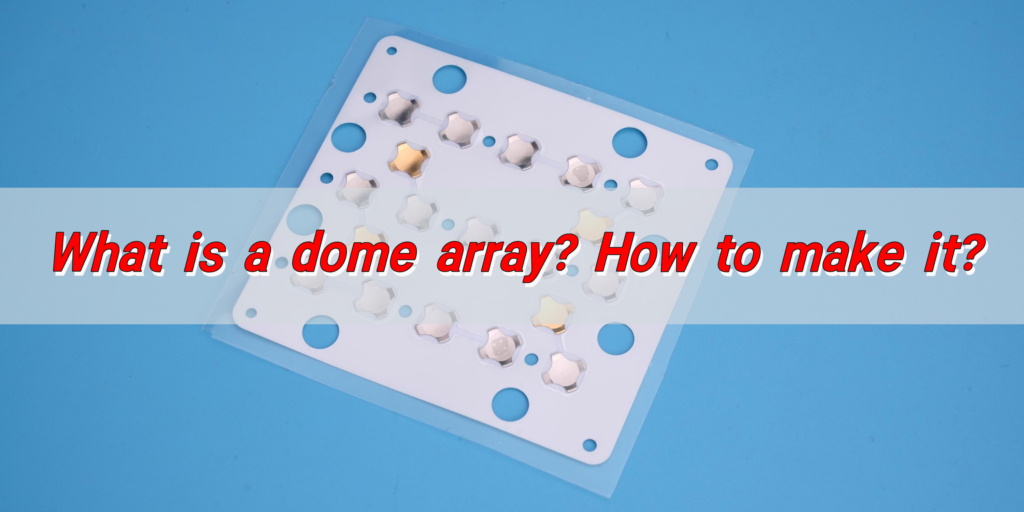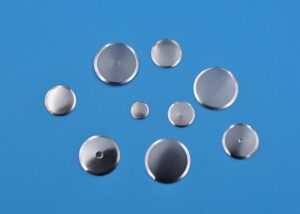The dome array is a component composed of multiple metal dome arranged in an orderly manner. When making it, first select materials such as stainless steel or copper alloy, and then form it through precision stamping and bending processes. Next, the formed dome array is pasted on the PET substrate to ensure accurate positioning. Finally, strict quality inspection is carried out to ensure that each dome can work properly.
How to make a dome array?
The first step in making a dome array is to choose the right material. Most manufacturers use PET film, known for its strength and flexibility, because it bonds securely to different layers during assembly.
Then comes Maylar, a brand of durable polyester film. It’s often used interchangeably with PET but is known for its resilience and smooth surface.
The domes themselves, usually stainless steel, are placed with exact alignment onto the PET or Maylar film. A top adhesive layer may cover them, or a spacer might be added to control actuation force. Precision tools place each snap dome in its exact position, ensuring reliable response and conductivity.
How to apply dome array to membrane switch?
The true value of dome arrays is revealed when they are integrated into membrane switches. These switches are thin, flexible user interfaces made of several layers—each with a unique function.
The adhesive process is critical. It must be clean, controlled, and perfectly aligned. You can’t afford errors here—every dome must be precisely positioned. The most common way to stick the dome array to the circuit is by using a high-clarity PET adhesive film or Maylar sheet.
Here’s how it’s done:
- Align the Dome Array: Place the metal dome array over the printed circuit, aligning each dome exactly over its contact point.
- Use Maylar or PET Film with Adhesive: Next, apply a pre-cut layer of adhesive PET film or Maylar with openings (known as vent holes) where domes sit. This film holds the domes firmly in place, yet still allows air to escape when pressed. It prevents false actuations and ensures a snappy, satisfying feel every time the key is pressed.
- Press and Seal: Using gentle but firm pressure, seal the dome array onto the circuit layer. Some manufacturers use lamination machines to ensure even bonding, while others do it by hand for custom builds.
- Final Overlay Application: After the dome array is fixed, the graphic overlay is applied on top. This top layer often features printed graphics or symbols and adds durability.
When applied correctly, every key press feels intentional—crisp, sharp, and error-free. This is the heart of what makes membrane switches so reliable across industries.
Whether it’s used in a rugged industrial panel or a sleek medical device, applying the dome array correctly is what transforms simple materials into a powerful human-machine interface.
How does dome array work in membrane switch?
Each metal dome has a convex shape. When you press down, it inverts, touching the lower circuit layer. This completes the circuit and sends a signal.
The second you release, the dome pops back to its original shape. This is the snap action—a click that your finger can feel.
This responsive action is essential. It tells the user the button has been pressed. The tactile feedback improves accuracy. It reduces user fatigue. And it increases confidence.
Some snap dome arrays even use gold-plated domes for better conductivity and corrosion resistance. Whether on medical equipment or control panels, this quick, clear response improves every interaction.
What is a snap dome switch and how does it function?
When you apply force to the top of a snap dome, it collapses inward. It makes contact with the conductive pad below. Once that connection is made, the device reads a signal: ON. Lift your finger, and the dome pops back: OFF.
This function is mechanical and fast. There are no complex electronics involved. That’s why these switches are loved across industries. They’re durable, intuitive, and easy to install.
BEST Technology, a well-known dome manufacturer, produces a variety of dome shapes—four-leg, triangle, round, and oblong. Each has a unique feel and force requirement. This lets designers fine-tune their user interface to match the needs of the user.
How is a snap dome array used in custom keypad designs?
In custom keypads, every detail matters. The shape. The pressure. The click. The durability. Designers must balance all these needs.
Each dome can be selected for force, size, and feel. Want a softer press? Choose a dome with lower actuation force. Need a sharper click? Go with a taller dome. Need to reduce space? Thin domes work in compact devices.
The array can be configured in any layout—square, staggered, or radial. This makes it ideal for custom keypads used in industries like medical devices, remote controls, elevators, and industrial panels.
Domes can even be placed under clear windows, allowing for LED lighting to shine through. You can also combine them with capacitive elements.
What is the HS code for dome arrays?
Every exported or imported item has an HS code—a number that classifies it for international trade. The dome array HS code typically falls under:
8536.50.90 – “Other switches, electrical apparatus for switching or protecting electrical circuits.”
This code may vary slightly depending on country-specific rules, but most suppliers and buyers use this classification. If you’re exporting or importing dome arrays, be sure to confirm with local customs or freight agents.
Where are metal dome arrays used?
Metal dome arrays are used everywhere. From medical monitors to smart locks, they deliver fast, reliable inputs. They’re in automotive dashboards, industrial control panels, and consumer electronics.
They’re often used where reliability is non-negotiable. In aerospace, they can help control safety systems. In healthcare, they guide nurses and doctors. In factories, they hold up under hours of continuous use.
How is a snap dome array different from rubber domes?
Snap domes are made of metal. They snap crisply when pressed. The feedback is sharp, immediate, and clean. There’s a distinct tactile “click.” Metal domes also have longer life spans—often millions of cycles.
Rubber domes, on the other hand, are made from silicone or rubber. They deform gently when pressed. The feedback is soft. Sometimes, it’s even hard to tell when a key has been activated. Over time, rubber can lose its bounce.
This difference is vital. In high-performance applications, metal dome arrays win. They offer more accuracy, better tactile response, and longer durability.
Conclusion:
The dome array may be small, but its impact is huge. It brings tactile clarity, fast response, and long life to every product it touches. From its carefully crafted metal domes, to the precision of adhesive PET film and Maylar, every layer works together for performance.
If you’re looking to design or upgrade your interface, or need help sourcing high-quality dome arrays, reach out to us at sales@metal-domes.com













